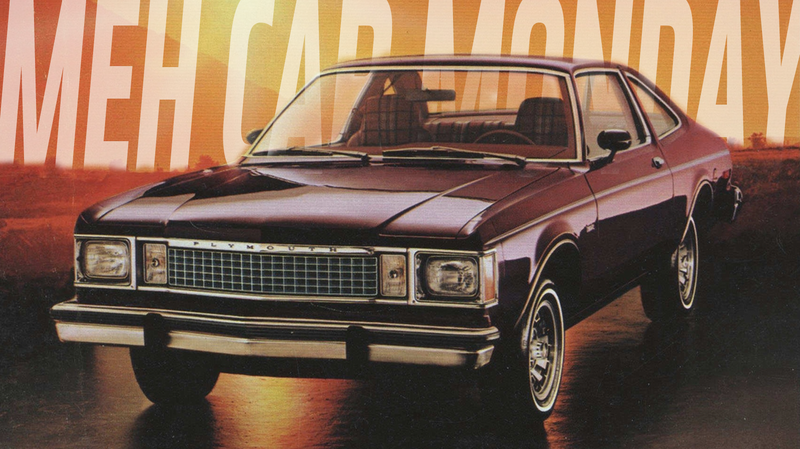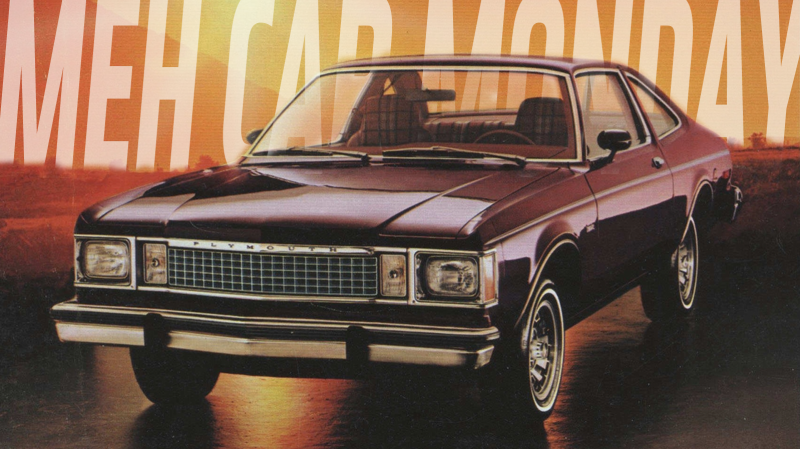
I bet if you assembled a dream team of the world’s most creative, open-minded, and visionary poets, freethinkers, and general imbibers of life’s rich, heady brew, and gave them a Plymouth Volare to feel, embrace, explore, experience, my guess is they’d come away thinking it’s “a car.” Maybe the more astute and/or high ones might realize it’s sort of old. That’s about the most you can hope for with a Volare.
The Plymouth Volare—sometimes written Volaré, with an accent over the “e,” even though the Italian word the name comes from (meaning “to fly”) has no accent—was introduced in 1976 as a replacement for the fairly popular Plymouth Valiant and Plymouth Duster.
The Valiant and Duster were Chrysler’s A-body cars, attempts to make compact, rear-wheel drive cars to compete with the Volkswagen Beetle, the Nash Rambler, and the new compacts coming from Ford and GM. These cars introduced the famous slant-6 inline-six engine, and were generally well-designed, well-built, and, well, well-liked. As well.
Advertisement
When the time came to replace the A-body cars, Chrysler developed the F-body cars, which maybe stood for “Foned-in,” because these were remarkably uninspired designs, so much so I wouldn’t be shocked they nobody could be bothered to spell “phone” properly in the fake name-meaning I just made up there.
Chrysler wanted something that felt a little bigger, a little more luxurious than the A-bodies, and while they were starting from scratch, the designers and engineers were forced to use as many existing parts-bin bits as possible, effectively neutering any radically different ideas before they started.
The result were cars that were about as engaging as a boiled Maytag repair manual served on a bed of drywall chips. Most of the development went into making things cheaper or quieter and softer, via a notably comprehensive plan of isolating almost anything bolted to anything else with rubber grommets or bushings or whatever.
Advertisement
The softly-sprung, fairly quiet chassis was made motile with one of three engine options, mostly holdovers from the last generation: a 100 horsepower (90 if you lived in California, you hippie) Slant-6, a 5.2-liter V8 making a Malaise-tastic 145 hp, and a 5.9-liter V8 making 170 hp. These spun wheels through, usually, a three-speed auto, or, if you were a cheapskate, a three-speed, column-shifted manual, or, if you were feeling saucy, a floor-shifted three or four speed.
At about 4,000 pounds, no Volare was all that quick, and handling was, even by the standards of the era, wallowy and vague. I’ve driven these on the highway before; it’s something of a challenge—a squishy, lolling challenge—to keep these things straight and in their lane.
Advertisement
The styling of the Volare managed to be both fussy and forgettable, all at once. Proportions were classic car-on-the-no-parking-sign-silhouette, laden with vinyl tops and rubber bump strips and tacked-on trim.
Some versions did have amber rear indicators, which was sort of a bold move for an American car, so credit where credit is due.
Advertisement
The Volare wasn’t really much worse than some of the other crap out there, like the Ford Monarch, for example, but there was very little to make it compelling, either.
The marketing team must have known this, and decided to focus on the car’s name for most of the early advertising, since there was a popular Italian/English song by the name, a popular version sung by Sergio Franchi.
Advertisement
Chrysler threw the crooner some cash and recorded a special version with Volare-the-car-related lyrics that they released on a special promotional LP:
They then turned that into a commercial for the Volare, establishing Chrysler’s love for spokesmen with rich, supple accents:
Sergio there does a lot of smooth-talking about how the car is small (!) and comfortable, and, um, beautiful. Also here Volaré has its accent mark, which Sergio tells us is “an accent on comfort.”
Advertisement
By 1980, the Volaré got a facelift that managed to make the car even more boring, and they celebrated this by making commercials that got rid of the previous cologne-soaked faux-Italian charm from before, and replaced it with a combination of boring suits talking features at you and a guy who looks like Rocky Balboa’s brother-in-law:
The Volare was, let’s be honest here, a soft, unlovable lump of crap, but, by mid-Malaise standards, that’s not enough to make it actually terrible. It just makes it, you guessed it, meh.
Advertisement
Nobody gives a shit about Volares. Sure, they made some sort of goofily fun sticker packages like the Volaré Funrunner, with its slatted rear quarter windows, perhaps an effort to keep all that running fun from escaping the car, but these were just half-ass sticker jobs.
I’m sure there’s going to be some Volarlover out there who will insist that these were fantastic, under-appreciated classics easily on par with the Mustang or Camaro in the American Pantheon, but my gut tells me that if such a person tried to gather everyone who agreed for a VolaréCon F-body Festival Of Love, they could rent out an elevator to hold it in and have room to spare.
Advertisement
The only saving grace I can think of is that a T-top version was available; but it says a lot about the fundamental mehndacity of a car if it can be had with a T-top and still be meh.
Which, of course, the Volare is.















